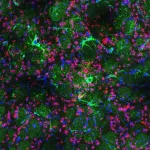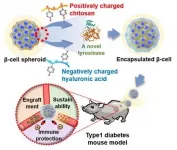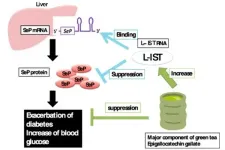How neurons get past 'no'
Inhibitory neurons target the weakest-responding neurons in the brain to facilitate transmission of signals
2021-06-24
(Press-News.org) LA JOLLA--(June 24, 2021) When looking at a complex landscape, the eye needs to focus in on important details without losing the big picture--a charging lion in a jungle, for example. Now, a new study by Salk scientists shows how inhibitory neurons play a critical role in this process.
The study, published May 25, 2021, in the journal Cell Reports, shows that inhibitory neurons do more than just inhibit neuron activity like an off-switch; paradoxically, they actually increase the amount of information transmitted through the nervous system when it needs to be flexible. To make this possible, inhibitory neurons need to be integrated into the circuit in a specific way. These observations could help scientists better understand and treat disorders involving our ability to focus and modulate signals based on the bigger picture, which are altered in conditions such as anxiety and attention deficit disorders.
"This work points to a new role for inhibitory neurons, which are usually just thought to be suppressors and organizers of activity," says Professor Tatyana Sharpee, who led the study. "The role of inhibitory neurons extends much further. By targeting only the most sparsely responding neurons, inhibitory neurons make it possible for the whole circuit to function well. That's completely new."
The new work was motivated by unanswered questions from a previous study of the diversity of response rates among neurons in the retina. The retina is a part of the eye that converts lights to electrical signals to be sent to the brain. "Remarkably, when we looked at retina cells that were not responding very much, their rates of information transfer actually increased in the presence of modulation," says first author Wei-Mien Hsu, a postdoctoral fellow in the Sharpee lab. "The trick for making this unexpected phenomenon possible is to apply the modulation signal via inhibitory neurons."
While the researchers tested the theory in neurons involved in vision, the findings could apply widely to neurons found throughout the brain and nervous system, adds Sharpee, who holds the Edwin K. Hunter Chair at Salk.
The next step in this line of research is to study how the phenomenon works in large sets of neurons.
INFORMATION:
Other authors on the study were David B. Kastner of the University of California San Francisco School of Medicine and Stephen A. Baccus of the Stanford University School of Medicine.
The research was supported by an AHA-Allen Initiative in Brain Health and Cognitive Impairment award, 19PABH134610000; a National Institute On Aging Award, P30AG068635; an NSF grant IIS-172442; an NSF Next Generation Networks for Neuroscience Program award, 2014217), NIH grants U19NS112959 and P30AG068635; a 2016 Salk Women & Science Special Award; a Bert and Ethel Aginsky Research Scholar Award, and NIH ( NEI) grants R01EY022933 and R01EY025087.
About the Salk Institute for Biological Studies:
Every cure has a starting point. The Salk Institute embodies Jonas Salk's mission to dare to make dreams into reality. Its internationally renowned and award-winning scientists explore the very foundations of life, seeking new understandings in neuroscience, genetics, immunology, plant biology and more. The Institute is an independent nonprofit organization and architectural landmark: small by choice, intimate by nature and fearless in the face of any challenge. Be it cancer or Alzheimer's, aging or diabetes, Salk is where cures begin. Learn more at: salk.edu.
ELSE PRESS RELEASES FROM THIS DATE:
2021-06-24
UNIVERSITY PARK, Pa. -- It can be difficult to get young kids to eat enough vegetables, but a new Penn State study found that simply adding more veggies to their plates resulted in children consuming more vegetables at the meal.
The researchers found that when they doubled the amount of corn and broccoli served at a meal -- from 60 to 120 grams -- the children ate 68% more of the veggies, or an additional 21 grams. Seasoning the vegetables with butter and salt, however, did not affect consumption.
The daily recommended amount of vegetables for kids is ...
2021-06-24
Rude behavior at work has come to be expected, like donuts in the breakroom. Two decades of research on employee relationships shows that 98 percent of employees experience rude behavior at work, but now a new study suggests a large majority of workplace relationships are not characterized by rudeness. Isolated incidents of rude behavior at work, although somewhat common, do not point to widespread incivility between employees and their colleagues, according to a new UCF study.
"Because prior research suggests workplace mistreatment is harmful and widespread, it is often called an epidemic, but our findings show that rude behavior is less like the flu and more like cholera," says Shannon Taylor, an associate professor of management and co-author of the ...
2021-06-24
Berlin and Bath, 24th June 2021 - Precision-fermentation company Formo and the University of Bath co-published the first large-scale study of consumer acceptance for animal-free dairy products.
Researchers surveyed 5,054 individuals from Brazil, Germany, India, the UK, and the USA to understand what consumers think of animal-free dairy products.
Precision fermentation is a process that allows specific proteins to be produced via microorganisms. By inserting a copied stretch of cow DNA, microorganisms produce milk proteins. The process is more efficient than using animals to make proteins and avoids the negative side effects of industrial animal agriculture, which is responsible for 18% of all greenhouse gas emissions.
The findings of the study, published in ...
2021-06-24
Leukemia is a group of blood cancers that affects thousands of people worldwide. However, with advances in medicine, several different types of leukemia can be effectively treated with donor stem cells through allogenic stem cell transplantation (allo-SCT). One such type of leukemia is B-cell acute lymphoblastic leukemia (B-ALL), which is caused by uncontrolled proliferation and prolonged existence of cancerous B-cells. While allo-SCT can 'cure' B-ALL in several cases, there are also cases of failure, characterized by deterioration in health after a period ...
2021-06-24
The brain is not a passive recipient of injury or disease. Research has shown that when neurons die and disrupt the natural flow of information they maintain with other neurons, the brain compensates by redirecting communications through other neuronal networks. This adjustment or rewiring continues until the damage goes beyond compensation.
This process of adjustment, a result of the brain's plasticity, or its ability to change or reorganize neural networks, occurs in neurodegenerative conditions such as Alzheimer's, Parkinson's and Huntington's disease (HD). As the conditions progress, many genes change the way they are normally expressed, turning some genes up and others down. The challenge for researchers like Dr. Juan Botas ...
2021-06-24
The central goal of cloud computing is to provide fast, easy-to-use computing and data storage services at a low cost. However, the cloud environment comes with data confidentiality risks attached.
Cryptography is the primary tool used to enhance the security of cloud computing. This mathematical technique protects the stored or transmitted data by encrypting it, so that it can only be understood by intended recipients. While there are many different encryption techniques, none are completely secure, and the search continues for new technologies that can counter the rising threats to data privacy and security.
In a recent study published in KeAi's International Journal of Intelligent Networks, a team of researchers from India and Yemen describe a novel, two-step cryptography ...
2021-06-24
A research team, led by Prof. Nathaniel S. Hwang and Prof. Byung-gee Kim, from Seoul National University (SNU) and Prof. Dong Yun Lee, from Hanyang University, has used enzymatic crosslinking to create nanofilms on cell surfaces. SNU has announced that it has developed a "cell caging" technology for the applications in cell-based therapies. The "cell caging" technique can prevent immune rejection during heterologous islet cell transplantation, facilitate smooth cell insulin secretion, and treat type 1 diabetic patients without immunosuppressants.
The research team succeeded in producing a nanofilm by using the electrostatic force to stack chitosan, which is a biological polymer, and hyaluronic acid in that order. To overcome the shortcomings ...
2021-06-24
Across the world, type 2 diabetes is on the rise. A research group has discovered a new gene that may hold the key to preventing and treating lifestyle related diseases such as type 2 diabetes.
The results of their research were published in the journal Nucleic Acids Research on June 18, 2021.
Selenoprotein P (SeP) is an essential plasma protein containing the micronutrient selenium. However, too much SeP spells trouble.
Excess SeP increases insulin resistance, thus weakening the effect of insulin, and worsening the metabolism of glucose.
"Excess SeP is the enemy when it comes to type 2 diabetes," stressed professor Yoshiro Saito from the Graduate School of Pharmaceutical Sciences at Tohoku University and co-author of the ...
2021-06-24
Female elephant seal weigh on average 350 kg, and dive continuously to the ocean's mesopelagic zone, about 200 to 1,000 meters deep, to consume their only prey: small fish that weigh less than 10 grams. Now, an international team of researchers, armed with eight years of data, may have answered a decades-long question: How do seals maintain their large size on such small prey?
They published their answer on May 12 in Science Advances.
"It is not easy to get fat," said paper author Taiki Adachi, research fellow with the National Institute of Polar Research and the School of Biology, University of St Andrews. "Elephant seals have to spend almost ...
2021-06-24
Genome study reveals East Asian coronavirus epidemic 20,000 years ago
An international study has discovered a coronavirus epidemic broke out in the East Asia region more than 20,000 years ago, with traces of the outbreak evident in the genetic makeup of people from that area.
Professor Kirill Alexandrov from CSIRO-QUT Synthetic Biology Alliance and QUT's Centre for Genomics and Personalised Health, is part of a team of researchers from the University of Arizona, the University of California San Francisco, and the University of Adelaide who have published their findings in the journal Current Biology.
In the past 20 years, there have been three outbreaks of epidemic severe coronaviruses: ...
LAST 30 PRESS RELEASES:
[Press-News.org] How neurons get past 'no'
Inhibitory neurons target the weakest-responding neurons in the brain to facilitate transmission of signals






